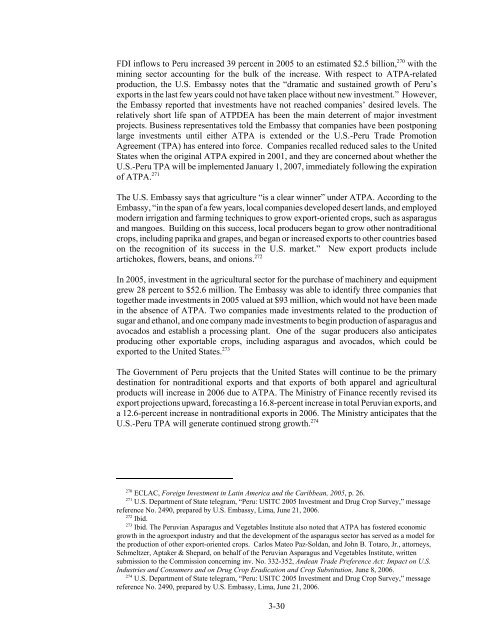The Impact of the Andean Trade Preference Act Twelfth ... - USITC
The Impact of the Andean Trade Preference Act Twelfth ... - USITC
The Impact of the Andean Trade Preference Act Twelfth ... - USITC
- No tags were found...
Create successful ePaper yourself
Turn your PDF publications into a flip-book with our unique Google optimized e-Paper software.
FDI inflows to Peru increased 39 percent in 2005 to an estimated $2.5 billion, 270 with <strong>the</strong>mining sector accounting for <strong>the</strong> bulk <strong>of</strong> <strong>the</strong> increase. With respect to ATPA-relatedproduction, <strong>the</strong> U.S. Embassy notes that <strong>the</strong> “dramatic and sustained growth <strong>of</strong> Peru’sexports in <strong>the</strong> last few years could not have taken place without new investment.” However,<strong>the</strong> Embassy reported that investments have not reached companies’ desired levels. <strong>The</strong>relatively short life span <strong>of</strong> ATPDEA has been <strong>the</strong> main deterrent <strong>of</strong> major investmentprojects. Business representatives told <strong>the</strong> Embassy that companies have been postponinglarge investments until ei<strong>the</strong>r ATPA is extended or <strong>the</strong> U.S.-Peru <strong>Trade</strong> PromotionAgreement (TPA) has entered into force. Companies recalled reduced sales to <strong>the</strong> UnitedStates when <strong>the</strong> original ATPA expired in 2001, and <strong>the</strong>y are concerned about whe<strong>the</strong>r <strong>the</strong>U.S.-Peru TPA will be implemented January 1, 2007, immediately following <strong>the</strong> expiration<strong>of</strong> ATPA. 271<strong>The</strong> U.S. Embassy says that agriculture “is a clear winner” under ATPA. According to <strong>the</strong>Embassy, “in <strong>the</strong> span <strong>of</strong> a few years, local companies developed desert lands, and employedmodern irrigation and farming techniques to grow export-oriented crops, such as asparagusand mangoes. Building on this success, local producers began to grow o<strong>the</strong>r nontraditionalcrops, including paprika and grapes, and began or increased exports to o<strong>the</strong>r countries basedon <strong>the</strong> recognition <strong>of</strong> its success in <strong>the</strong> U.S. market.” New export products includeartichokes, flowers, beans, and onions. 272In 2005, investment in <strong>the</strong> agricultural sector for <strong>the</strong> purchase <strong>of</strong> machinery and equipmentgrew 28 percent to $52.6 million. <strong>The</strong> Embassy was able to identify three companies thattoge<strong>the</strong>r made investments in 2005 valued at $93 million, which would not have been madein <strong>the</strong> absence <strong>of</strong> ATPA. Two companies made investments related to <strong>the</strong> production <strong>of</strong>sugar and ethanol, and one company made investments to begin production <strong>of</strong> asparagus andavocados and establish a processing plant. One <strong>of</strong> <strong>the</strong> sugar producers also anticipatesproducing o<strong>the</strong>r exportable crops, including asparagus and avocados, which could beexported to <strong>the</strong> United States. 273<strong>The</strong> Government <strong>of</strong> Peru projects that <strong>the</strong> United States will continue to be <strong>the</strong> primarydestination for nontraditional exports and that exports <strong>of</strong> both apparel and agriculturalproducts will increase in 2006 due to ATPA. <strong>The</strong> Ministry <strong>of</strong> Finance recently revised itsexport projections upward, forecasting a 16.8-percent increase in total Peruvian exports, anda 12.6-percent increase in nontraditional exports in 2006. <strong>The</strong> Ministry anticipates that <strong>the</strong>U.S.-Peru TPA will generate continued strong growth. 274270ECLAC, Foreign Investment in Latin America and <strong>the</strong> Caribbean, 2005, p. 26.271U.S. Department <strong>of</strong> State telegram, “Peru: <strong>USITC</strong> 2005 Investment and Drug Crop Survey,” messagereference No. 2490, prepared by U.S. Embassy, Lima, June 21, 2006.272 Ibid.273 Ibid. <strong>The</strong> Peruvian Asparagus and Vegetables Institute also noted that ATPA has fostered economicgrowth in <strong>the</strong> agroexport industry and that <strong>the</strong> development <strong>of</strong> <strong>the</strong> asparagus sector has served as a model for<strong>the</strong> production <strong>of</strong> o<strong>the</strong>r export-oriented crops. Carlos Mateo Paz-Soldan, and John B. Totaro, Jr., attorneys,Schmeltzer, Aptaker & Shepard, on behalf <strong>of</strong> <strong>the</strong> Peruvian Asparagus and Vegetables Institute, writtensubmission to <strong>the</strong> Commission concerning inv. No. 332-352, <strong>Andean</strong> <strong>Trade</strong> <strong>Preference</strong> <strong>Act</strong>: <strong>Impact</strong> on U.S.Industries and Consumers and on Drug Crop Eradication and Crop Substitution, June 8, 2006.274U.S. Department <strong>of</strong> State telegram, “Peru: <strong>USITC</strong> 2005 Investment and Drug Crop Survey,” messagereference No. 2490, prepared by U.S. Embassy, Lima, June 21, 2006.3-30
















